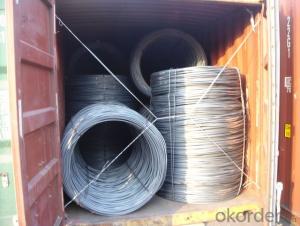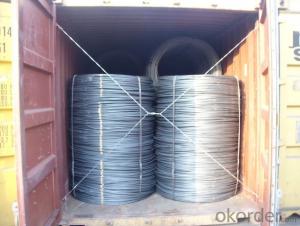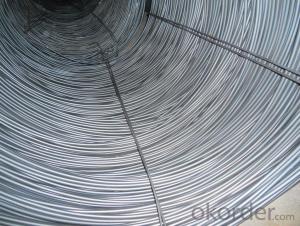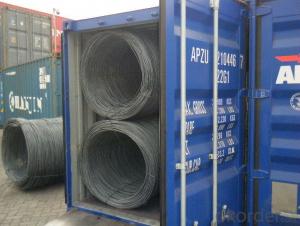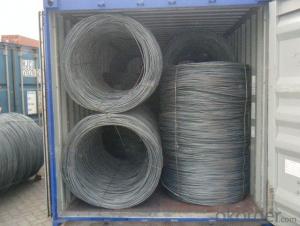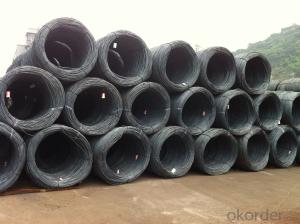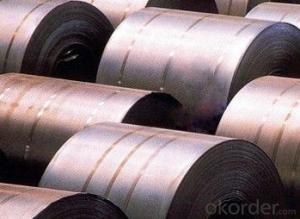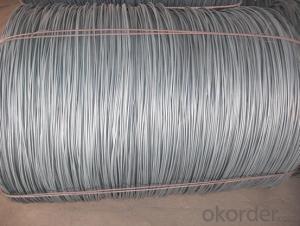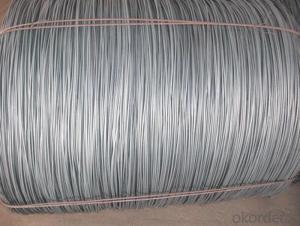Hot Rolled Wire Rod of Steel Grade: Q195/235
- Loading Port:
- Tianjin
- Payment Terms:
- TT OR LC
- Min Order Qty:
- 100 m.t.
- Supply Capability:
- 2000 m.t./month
OKorder Service Pledge
OKorder Financial Service
You Might Also Like
Product Description:
OKorder is offering Hot Rolled Wire Rod of Steel Grade: Q195/235 at great prices with worldwide shipping. Our supplier is a world-class manufacturer of steel, with our products utilized the world over. OKorder annually supplies products to European, North American and Asian markets. We provide quotations within 24 hours of receiving an inquiry and guarantee competitive prices.
Product Applications:
Hot Rolled Wire Rod of Steel Grade: Q195/235 are ideal for structural applications and are widely used in the construction of buildings and bridges, and the manufacturing, petrochemical, and transportation industries.
Product Advantages:
OKorder's Hot Rolled Wire Rod of Steel Grade: Q195/235 are durable, strong, and resist corrosion.
Main Product Features:
· Premium quality
· Prompt delivery & seaworthy packing (30 days after receiving deposit)
· Corrosion resistance
· Can be recycled and reused
· Mill test certification
· Professional Service
· Competitive pricing
Specifications of Hot Rolled Wire Rod:
Steel Grade: Q195/235, SAE1006-1018B Standard: ASTM, GB
Diameter: 5.5mm, 6.5mm, 7mm,8mm,9mm,10mm,12mm,14mm
Type: in coil, coil weight around 2MT Alloy or Not: Alloy
Technique: Hot Rolled
Place of Origin: China Mainland
Surface: round, no twisted, light and smooth
Chemical Composition: (Please kindly find our chemistry of our material based on Q195、Q235A and Q235B as below for your information)
Trademark | Rank | Chemical composition (quality score) % | ||||||
C | Si | Mn | S | P | ||||
| ≤ |
| ≤ | ≤ | ||||
Q195 |
| 0.06-0.12 | 0.30 | 0.25 | 0.050 | 0.045 | ||
Q235 | A | 0.14-0.22 | 0.30 | 0.30-0.65 | 0.050 | 0.045 | ||
Q235 | B | 0.12-0.20 | 0.30 | 0.30-0.70 | 0.045 | 0.045 | ||
Usage and Applications of Hot Rolled Wire Rod:
After hot-rolled the products shaped into coil and delivery as finished product, including round, square, rectangular, hexagonal and so on. Since most of the products are round, it is generally called wire rod. Carbon steel wire rod is widely used in construction and manufacturing. Carbon steel wire rod is mainly used for reinforcement of reinforced concrete and welded structure or reprocessed (roberts , nail, etc.) materials, especially used to produce wire drawing, welding electrode, nails, spring, electronic, precise machinery parts and so on.
Packaging & Delivery of Hot Rolled Wire Rod:
Packaging Detail: products are packed in coil, each coil weight around 2 MT, and then shipped by container or bulk vessel
Delivery Detail: within 45 days after received deposit or LC.
Label: to be specified by customer, generally, each bundle has 1-2 labels
Trade terms: FOB, CFR, CIF
FAQ:
Q1: Why buy Materials & Equipment from OKorder.com?
A1: All products offered byOKorder.com are carefully selected from China's most reliable manufacturing enterprises. Through its ISO certifications, OKorder.com adheres to the highest standards and a commitment to supply chain safety and customer satisfaction.
Q2: How do we guarantee the quality of our products?
A2: We have established an advanced quality management system which conducts strict quality tests at every step, from raw materials to the final product. At the same time, we provide extensive follow-up service assurances as required.
Q3: How soon can we receive the product after purchase?
A3: Within three days of placing an order, we will begin production. The specific shipping date is dependent upon international and government factors, but is typically 7 to 10 workdays.
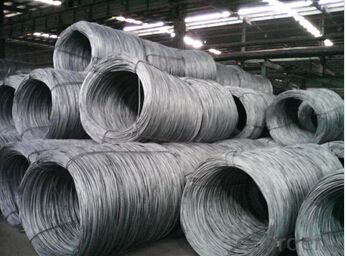
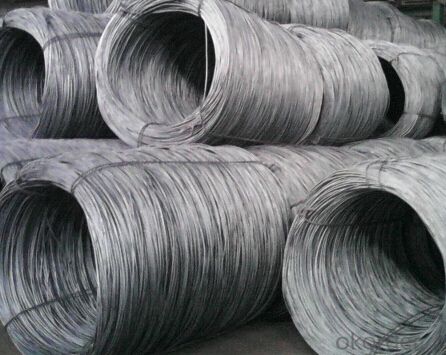
- Q:What are the different shapes available for steel wire rod?
- The different shapes available for steel wire rod include round, square, hexagonal, and flat.
- Q:What are the different types of steel wire rod coatings used for improved electrical conductivity?
- There are several types of steel wire rod coatings used for improved electrical conductivity, including copper, tin, silver, and nickel. These coatings help enhance the wire's ability to conduct electricity by reducing resistance and improving the flow of electrical current.
- Q:What are the typical mechanical properties of steel wire rod?
- The typical mechanical properties of steel wire rod can vary depending on the grade and specific composition of the steel used. However, there are some general mechanical properties that are commonly observed in steel wire rods. One of the most important mechanical properties of steel wire rod is its tensile strength. Steel wire rods are known for their high tensile strength, which is the maximum amount of stress or load that the rod can withstand before breaking. The tensile strength of steel wire rods can range from a few hundred megapascals (MPa) to several thousand MPa, depending on the grade and processing of the steel. Another important mechanical property of steel wire rod is its ductility. Ductility refers to the ability of a material to undergo plastic deformation without fracturing. Steel wire rods are generally known for their high ductility, allowing them to be easily formed and shaped without breaking. This property is crucial for applications that require the wire rod to be bent, twisted, or pulled during use. Steel wire rods also exhibit good toughness, which is the ability of a material to absorb energy and resist fracture when subjected to impact or sudden loads. This property makes steel wire rods suitable for applications that involve dynamic loading or high impact forces, such as in construction, automotive, or machinery industries. Furthermore, steel wire rods typically have excellent corrosion resistance, especially when they are coated or treated to enhance their protective properties. This resistance to corrosion is essential in applications where the wire rod is exposed to harsh environments or corrosive substances. In addition to these properties, steel wire rods also possess good thermal and electrical conductivity, making them suitable for various applications in the electrical and electronics industries. It is important to note that the specific mechanical properties of steel wire rods can be tailored through various processing techniques, such as heat treatment, cold working, or alloying. Different grades of steel wire rods may have specific mechanical properties that are optimized for specific applications, such as high-strength wire rods for reinforcement purposes or low-carbon wire rods for general-purpose uses. Overall, the typical mechanical properties of steel wire rod include high tensile strength, good ductility, toughness, corrosion resistance, and thermal and electrical conductivity. These properties make steel wire rods versatile and widely used in various industries.
- Q:How is steel wire rod used in the manufacturing of wire forms for fishing nets?
- Steel wire rod is used in the manufacturing of wire forms for fishing nets as it serves as the primary material for creating the core structure of the nets. The wire rod is typically shaped and twisted into specific designs to form the framework and support system of the fishing net. Its strong and durable properties make it ideal for withstanding the tension and pressure exerted by water currents and the weight of captured fish, ensuring the longevity and effectiveness of the fishing net.
- Q:What are the major players in the steel wire rod industry?
- Some of the major players in the steel wire rod industry include ArcelorMittal, Nippon Steel Corporation, Tata Steel, EVRAZ, and Gerdau. These companies have a significant global presence and play a key role in the production and supply of steel wire rods.
- Q:How is steel wire rod used in the production of wire ropes for mining applications?
- Steel wire rod is used as the primary raw material in the production of wire ropes for mining applications. It serves as the foundation for creating the wire strands that make up the rope. The wire rod is first cleaned and coated to enhance its durability and resistance to corrosion. It is then drawn through a series of dies to reduce its diameter and increase its strength. These drawn wires are then twisted or braided together to form the wire strands, which are further assembled into wire ropes used in mining operations. The high strength and resilience of steel wire rod make it a crucial component in ensuring the safety and reliability of wire ropes used in demanding mining conditions.
- Q:What are the different types of wire drawing dies used for steel wire rod?
- Steel wire rod can be drawn using several types of wire drawing dies. These dies vary in their composition and characteristics. Here are the different types commonly used: 1. Single crystal natural diamond dies: These dies, made from a single crystal diamond, are renowned for their exceptional hardness and resistance to wear. They are suitable for drawing both high carbon steel wire rod and stainless steel wire rod. 2. Polycrystalline diamond (PCD) dies: PCD dies are crafted by bonding multiple small diamond crystals together. They offer good wear resistance and can be used for drawing steel wire rod with intermediate carbon content. 3. Tungsten carbide dies: Utilizing tungsten carbide, a tough and durable material, these dies are often employed for wire drawing. They can handle high carbon steel wire rod and are capable of withstanding high pressures and temperatures. 4. Natural diamond dies with carbide support: These dies possess a core made of natural diamond, providing excellent wear resistance, while a carbide support structure adds strength and stability. They are suitable for drawing steel wire rod with high carbon content. 5. PCD dies with carbide support: Similar to the previous type, these dies have a PCD core and a carbide support structure. They offer good wear resistance and are suitable for steel wire rod with intermediate carbon content. 6. Polycrystalline diamond composite (PDC) dies: PDC dies are manufactured by sintering diamond particles with a binder material. They are well-known for their high wear resistance and are commonly used for drawing steel wire rod with low to medium carbon content. Each type of wire drawing die possesses unique advantages and is suitable for specific applications, depending on the carbon content and other properties of the steel wire rod being drawn.
- Q:How are steel wire rods stored to prevent corrosion?
- Steel wire rods are typically stored in a controlled environment, such as a warehouse, where proper temperature and humidity levels are maintained. They are often coated with a protective layer, such as rust-inhibiting oil or a corrosion-resistant coating, to prevent direct contact with moisture. Additionally, steel wire rods may be stored on pallets or racks, ensuring they are kept off the ground and away from any potential sources of moisture. Regular inspections and maintenance are also conducted to identify and address any signs of corrosion promptly.
- Q:How is the grain size of steel wire rod measured?
- The grain size of steel wire rod is typically measured using a microscope to observe the microstructure of the material. The specimen is prepared by polishing and etching the surface, and then the grains are counted and measured using a standard measurement scale.
- Q:What are the safety requirements for steel wire rod used in elevator wire ropes?
- Ensuring the reliable and secure operation of elevators requires strict adherence to safety requirements for steel wire rod used in elevator wire ropes. These requirements, established by industry standards and regulations, guarantee the strength, durability, and performance of the wire ropes. Key safety requirements for steel wire rod in elevator wire ropes include: 1. Material Quality: Elevator wire ropes must use steel wire rod that meets specific material standards, typically set by organizations like ASTM. These standards define the chemical composition, mechanical properties, and other characteristics of the steel, ensuring it can withstand the necessary loads and stresses. 2. Strength: Elevator wire ropes experience significant loads and stresses during operation, so the steel wire rod must possess high tensile strength to withstand these forces without breaking. Industry standards establish minimum tensile strength requirements to ensure passenger safety and the reliability of the elevator system. 3. Fatigue Resistance: Due to repeated bending and flexing, elevator wire ropes are prone to fatigue failure if the steel wire rod lacks proper resistance. The steel wire rod should exhibit excellent fatigue resistance properties, enabling the wire rope to endure millions of cycles without degradation. 4. Surface Quality: The surface of the steel wire rod must be smooth and defect-free to avoid weakening the wire rope. Surface irregularities like pits, scratches, or deformations can act as stress concentration points, reducing the overall strength and safety of the wire rope. 5. Dimensional Accuracy: Proper fit and functionality require the steel wire rod to meet specific dimensional tolerances, including diameter, roundness, and straightness. These tolerances are vital for the correct assembly and operation of the wire ropes. 6. Testing and Certification: Manufacturers of steel wire rod for elevator wire ropes should conduct rigorous testing to ensure compliance with safety requirements. These tests may cover tensile strength, fatigue, surface inspection, and dimensional measurements. Certification from recognized bodies or compliance with industry standards like ISO 9001 further guarantees the quality and safety of the steel wire rod. By adhering to these safety requirements, elevator manufacturers and operators can have confidence in the reliability and performance of their wire ropes, ultimately ensuring passenger safety and the smooth functioning of elevator systems.
1. Manufacturer Overview |
|
|---|---|
| Location | |
| Year Established | |
| Annual Output Value | |
| Main Markets | |
| Company Certifications | |
2. Manufacturer Certificates |
|
|---|---|
| a) Certification Name | |
| Range | |
| Reference | |
| Validity Period | |
3. Manufacturer Capability |
|
|---|---|
| a)Trade Capacity | |
| Nearest Port | |
| Export Percentage | |
| No.of Employees in Trade Department | |
| Language Spoken: | |
| b)Factory Information | |
| Factory Size: | |
| No. of Production Lines | |
| Contract Manufacturing | |
| Product Price Range | |
Send your message to us
Hot Rolled Wire Rod of Steel Grade: Q195/235
- Loading Port:
- Tianjin
- Payment Terms:
- TT OR LC
- Min Order Qty:
- 100 m.t.
- Supply Capability:
- 2000 m.t./month
OKorder Service Pledge
OKorder Financial Service
Similar products
New products
Hot products
Hot Searches
Related keywords
